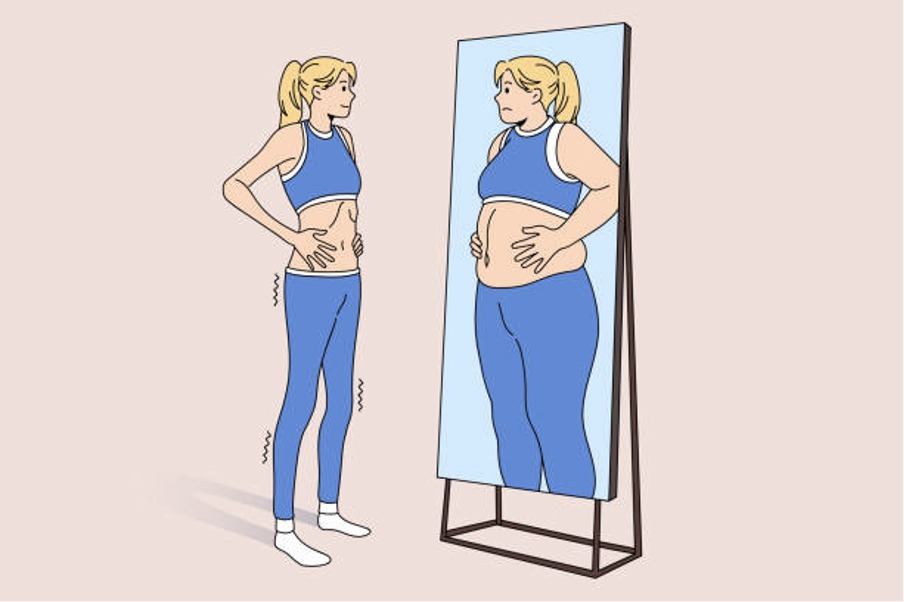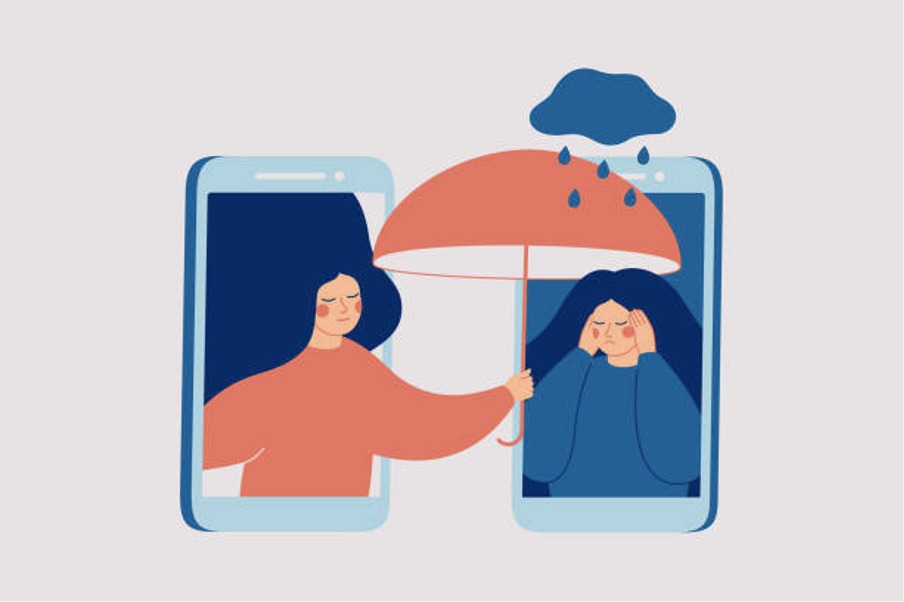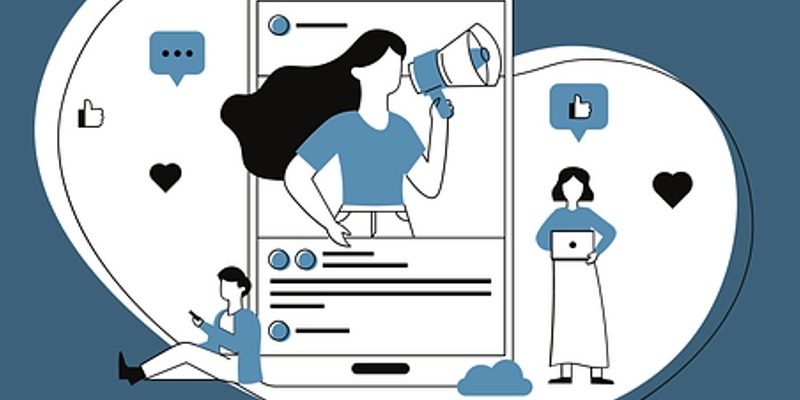By Pandora Pantazi and Anna Vornlocher
The use of social media is commonplace in teenager’s lives and it functions as a constant companion. Adolescents and young adults in particular pose as a major and vulnerable group and are receptive to negative influences with long-term consequences that come along with excessive social media consumption [1]. This development is also increasingly being observed in science. Here we argue that the current social media use of adolescents, poses a major threat to their well-being and is stress inducing, especially by focusing on the exposure to heavily edited content on social media platforms.
How can this affect adolescents’ body image?
Body image is a complicated term referring to a subjective evaluation of the body, which is increasingly being challenged by the depiction of perfect bodies and faces on social media [2]. On social platforms such as Instagram or Snapchat, users are constantly exposed to content that is posed, unnatural, and heavily edited. The use of filters and photo editing has developed to the use of filters that beautify the face and body and thus distort reality. These filters have become less noticeable and are used without a second thought to “quickly look a little fresher”.
Applying these filters or editing apps has effects such as smoother skin, whiter teeth, a healthy toned body, a smaller nose, or better shaped cheekbones.
What masquerades as a nice effect before posting a picture poses a great danger for adolescents and their well-being. However, the excessive exposure to heavily edited or distorted images impacts teenagers’ way of thinking about themselves and their bodies. Constantly comparing one’s own body with an ideal -and unrealistic- one can lead to body dissatisfaction and lower self-worth. The term body dissatisfaction can thus be defined as an individual’s negative thoughts and feelings about their own body [3].
“Around 40% of teenagers say
that social media makes them
question their own body”
Results of surveys reflect these heavy impressions of social media influence. A survey conducted by the Mental Health Foundation in Britain unmasked social media as a key influence when it comes to body image in teenagers. Around 40% of teenagers reported that social media caused them to question their own body. Moreover, more than one third of teenagers, aged between 13-19, reported indulging in dietary restriction due to worries about their body image [4]. Surveys and statistics show the impact of this illusory world on young people. In a survey in the US, 43% of teenagers said that social media would create pressure to post a certain type of content, namely only content in which they look good [5]. Furthermore, a study conducted in the US and UK asking teenagers about their negative feelings as a result of scrolling through Instagram revealed that another 41% of teenagers from the UK thought they were not attractive enough, 24% felt not good enough. Additionally, in this survey, 51% of US teenagers felt the need to create the perfect picture for Instagram, in line with the statistic of the UK above [6]. Another survey conducted in 2021 further shows the detrimental effects of social media use on younger generations as, for example, Gen Z was the leading generation rating social media as having a negative impact on social wellbeing, at 36% [7]. From these statistics, it becomes apparent that social media consumption changes the perception of the own body and increases body dissatisfaction, which results in higher stress levels due to the pressure to conform with these body standards.
Peer pressure creates the link between social media and body dissatisfaction
More than a century before, psychologist Stanley Hall described adolescence as a time of “storm and stress” [8], with stress being an integral part of this life-stage. Researchers from the Australian National University examined the relationship between stress and body imagein high school students in Australia. Adolescent self-reports highlighted the important role of stress in body image as higher levels of stress were related to disturbed body image and worse mental health with lower self-esteem and more depressive symptoms, especially for females. As most would expect, stress related to peers seemed to have a considerable impact on both males and females with peer evaluations of masculinity and attractiveness being of great importance for them respectively [9]. The central role of peer stress is not surprising as adolescents tend to value peer approval while designing their road to autonomy and defining themselves through relationships that are not based on family ties. Self-perceptions are built upon the evaluations of peers about one’s physical appearance, thus higher peer stress relates to lower self-esteem and higher body dissatisfaction [10]. At present, self-evaluations and social comparisons have been facilitated and expanded with social media use. Comparing oneself not only to celebrities’ images posted online but also to close friends has been associated with more negative body image evaluations in adolescent females [11].
In conclusion, peer pressure and the significance of peer approval forms the basis for the upward comparisons. As social media is the most popular way of communication and interaction among teenagers, beauty stereotypes that are promoted through them exert pressure to resemble the ideal appearance. Thus, the ideal appearance is a means for adolescents to receive positive evaluations by their peers.
How well-being is influenced by social media behaviours: self-objectification and self-optimization
The internalization of the ideal body type is reflected in the behavioural patterns of social media users. Focusing on the appearance of others and rating their worth by how they look is apparent in media like Instagram and Facebook where the main product is users’ photos. Self-objectification behaviours include posting photos and thinking of oneself as a total of body parts that others “like or dislike” and are related to increased anxiety and preoccupation with one’s body image. An American study examining early adolescents (14 to 16 years old) on the time they spent on social media and the impact on the perceptions of their body suggested that the greater the amount of self-objectification behaviours the higher the levels of body surveillance which consists of concentrating extensively on how one’s body looks. This attention evokes negative feelings and especially body shame which may be directed towards one’s body and self and can result in depressive symptoms and unhealthy eating behaviours that aim at adopting the ideal body appearance as suggested in the media [1].
The use of filters and photoshop is a widely used and accepted practice that gives the opportunity to create a more favourable picture of oneself and gives the illusion of an ideal appearance. The phenomenon is so widespread that it was described by Coy-Dibley with the term “digitized dysmorphia” which emphasizes the pressure to conform with ideal standards and is supposed to increase dysmorphic disorders among females [12]. The relationship between Instagram use and negative body image was supported in Italian adolescents aged 13 to 21 years. It was found that users that tended to edit their pictures experienced more anxiety and dissatisfaction towards their body, have internalized physical appearance standards to a greater extent and were more vulnerable to negative evaluations of their body image [13].

Social media and cosmetic surgery
Not to be neglected is the already existing extreme end of this challenge, namely the effect that social media and the exposure to cosmetically edited images not only leads to the dissatisfaction of one’s own body but to the desire to change it in ‘real life’. A direct effect of social media use on young women’s attitudes towards cosmetic treatments has been indicated in the literature. For instance, a study demonstrated that the exposure to edited images of women led to lower satisfaction with the own appearance and resulted in a more positive attitudes towards cosmetic surgery [14]. Although cosmetic procedures, body dissatisfaction and social media influence used to be considered more prevalent in females, recent studies suggest that males do not remain untouched. Being bombarded by images of well-shaped, muscular male bodies influences males’ body perceptions. Furthermore, poor body image and constant use of social networking sites serve as predictors for undertaking cosmetic enhancement treatments among males [15].
How adolescents combat the problem
How profound the effects really are needs to be researched on a scientific basis to find large-scale solutions. A study conducted in 2021 investigated adolescents’ processes of dealing with appearance-related content on social media and possible coping strategies [16]. Here it was found that direct appearance comparisons with peers, social media influencers, and celebrities were the main sources for eliciting body dissatisfaction. However, the study results show that teenagers already use various methods to avoid unwanted content on social media. These strategies were avoidance (e.g., unfollowing an account that conveys a certain body ideal or avoiding comparisons), the active selection of positive content in social media (e.g., subscribing to channels that represent one’s own body image), cognitive psychological distancing strategies (e.g., distinguishing between values and goals of celebrities/influencers and themselves, actively acknowledging edited content), and reframing strategies (e.g., taking a step back and looking at the bigger picture). Males used these methods more successfully, whereas females stated that all content about body images was negative for them. Another important finding from this study is that body positivity related content was not recognised if the facilitator (e.g., social media influencer) himself/herself conformed to the body ideal [16].
From the results of this study, it can be concluded that the awareness of the problems and attitude to fight does, at least partially, exist. However, adolescents are in a complicated phase of their lives and, as already mentioned, deal with stress and the influencing factors differently. Therefore, it is important to offer support that goes beyond the individual setting of one’s own social media profile.
Parental support and institutional education
How can parents or institutions such as schools draw attention to this manipulation of young people’s own body image? As this societal problem has a wide impact, it is important to find solutions and interventions that are both scientifically proven and applicable to a target group of young adults at the same time. One theoretical basis that could be used as an approach for creating interventions around the social media consumption of young people is the so-called boosting [9]. The idea behind the boosting technique would be to provide adolescents with the knowledge and skills to strengthen their own decision-making capacity.
Especially for young people, with the urge for self-discovery and independence, this technique leaves a lot of freedom. Boosts have emerged from the idea of nudging and can be defined as interventions that aim to target the competences of an individual rather than evoke an immediate change of behaviour. A further distinction is made between short-term and long-term boosts. The former deal with the determination of decisions for a specific situation, whereas a long-term boost imparts knowledge to be able to apply an approach beyond a specific situation. For young people in the developmental phase, it would therefore make sense to design long-term boosts that are not only related to social media and the consumption of edited images but can be applied across disciplines to benefit from the ability in other areas as well [17].
In practice, young people should be educated about body image and how it is influenced by social media, and they should be taught to reflect and rethink how to perceive their own bodies and recognise the longer-term effects of this excessive social media consumption and have sources accessible to them. By offering adolescents knowledge and critical thinking competencies, they can then decide for themselves whether they still want to pursue the behaviour (e.g., following accounts on Instagram that show body ideals) or whether the long-term costs and negative effects outweigh. This can be achieved by offering attention state training, teaching about strategic use of automated processes [17]. The aim is to show them the contents and context and give them the ability to critically question and understand them instead of simply prescribing ‘conscious media consumption’. By applying their knowledge, young adults will then hopefully change their consumption behaviour, or the content that they consume depending on their preference. Policy interventions that require schools to teach these certain skill sets would be in line with boosting theory.
Targeted more towards the specific challenge of overcoming body image problems, other studies also recommend the inclusion of stress management training or modules that are focused on self-esteem and reducing the importance that is put on the body per se [18]. Although this is more of a ‘nudge in the right direction’ and targeted towards a specific behaviour change, it might be essential to integrate. These ‘educative nudges’ are very similar to boosting. These nudges give teenagers the possibility to cope with existing stress, whereas boosting interventions should be integrated to prevent stress from occurring in the first place.
Changing the online environment
Furthermore, this problem can also be addressed by social media platforms themselves. In one study, for example, girls said they switched from Instagram to the app VSCO solely for the purpose of not feeling pressure to look good [16]. VSCO does not have the function to like or comment on images, hence the pressure to adhere to a certain body ideal is decreased as the option for validation that is visible for peers is erased.

Furthermore, influencers significantly contribute to the portrayal of the “ideal” and are thus connected to negative valence. However, influencers who are perceived as authentic could create a positive online environment. Body positive influencers who show their seemingly ‘imperfect’ body would be seen as more credible which is an important indicator for success [19]. Instagram now offers the possibility to turn off the comment and like function under one’s own pictures, but users can still see the amount of likes of other users’ pictures and recognise which content gets a positive response. However, Instagram has started pilot studies in some countries to test the removal of likes. Instagram also declared its intention to ‘depressurise’ the app appearance [4].
The problems of social media and its negative impact on adolescents’ perceptions on their body and mental health are increasingly being recognised not only by adults but by teenagers themselves. Knowing that adolescence is a challenging life period, it is now imperative to provide teenagers with knowledge and strategies on how to combat this problem.
References
[1] Salomon, I., & Brown, C. S. (2019). The Selfie Generation: Examining the Relationship Between Social Media Use and Early Adolescent Body Image. The Journal of Early Adolescence, 39(4), 539–560. https://doi.org/10.1177/0272431618770809
[2] Croll, J. (2005). Body image and adolescents. In Stang, J. & Story, M. (Eds.), Guidelines for Adolescent Nutrition Services. University of Minnesota
[3] Grogan, S. (1999). Body image: Understanding body dissatisfaction in men, women and children. Psychology Press.
[4] Mental Health Foundation. (2019). News: Millions of teenagers worry about body image and identify social media as a key cause – new survey by the Mental Health Foundation. https://www.mentalhealth.org.uk/about-us/news/millions-teenagers-worry-about-body-image-and-identify-social-media-key-cause-new-survey-mental
[5] Anderson, N. & Jiang, J. (2018). Teens & Tech: Teens’ social media habits and experiences. Pew Research Center. https://www.pewresearch.org/internet/2018/11/28/teens-social-media-habits-and-experiences/
[6] Facebook (2019, October). Negative feelings that originated after browsing Instagram according to teens in the United States and United Kingdom in 2019 [Chart]. Statista. https://www.statista.com/statistics/1280217/us-uk-teens-negative-feelings-instagram/
[7] Lululemon Athletica. (2022, February). Share of adults worldwide who feel that social media has a negative impact on social wellbeing as of November 2021, by generation [Chart]. Statista. https://www.statista.com/statistics/1314999/global-population-social-media-and-wellbeing-by-generation/
[8] Arnett J. J. (1999). Adolescent storm and stress, reconsidered. The American psychologist, 54(5), 317–326. https://doi.org/10.1037//0003-066x.54.5.317
[9] Murray, K. M., Byrne, D. G., & Rieger, E. (2011). Investigating adolescent stress and body image. Journal of adolescence, 34(2), 269–278. https://doi.org/10.1016/j.adolescence.2010.05.004
[10] Murray, K., Rieger, E., & Byrne, D. (2015). The relationship between stress and body satisfaction in female and male adolescents. Stress and health: Journal of the International Society for the Investigation of Stress, 31(1), 13–23. https://doi.org/10.1002/smi.2516
[11] Scully, M., Swords, L., & Nixon, E. (2020). Social comparisons on social media: online appearance-related activity and body dissatisfaction in adolescent girls. Irish journal of psychological medicine, 1–12. Advance online publication. https://doi.org/10.1017/ipm.2020.93
[12] Coy-Dibley, I. (2016). “Digitized Dysmorphia” of the female body: The re/disfigurement of the image. Palgrave Communications 2(1). https://doi.org/10.1057/palcomms.2016.40
[13] Verrastro, V., Fontanesi, L., Liga, F., Cuzzocrea, F. & Gugliandolo, M. (2020). Fear the Instagram: beauty stereotypes, body image and Instagram use in a sample of male and female adolescents. Qwerty. Open and Interdisciplinary Journal of Technology, Culture and Education. 15(1), 31-49. https://doi.org/10.30557/QW000021.
[14] Walker, C. E., Krumhuber, E. G., Dayan, S., & Furnham, A. (2019). Effects of social media use on desire for cosmetic surgery among young women. Current Psychology. 40, 3355-3364 https://doi.org/10.1007/s12144-019-00282-1
[15] Abbas, O. L., & Karadavut, U. (2017). Analysis of the Factors Affecting Men’s Attitudes Toward Cosmetic Surgery: Body Image, Media Exposure, Social Network Use, Masculine Gender Role Stress and Religious Attitudes. Aesthetic Plastic Surgery, 41(6), 1454–1462. https://doi.org/10.1007/s00266-017-0882-3
[16] Mahon, C. & Hevey, D. (2021). Processing body image on social media: Gender differences in adolescent boys’ and girls’ agency and active coping. Frontiers in Psychology. 12, 1664-1078. https://doi.org/10.3389/fpsyg.2021.626763
[17] Hertwig, R., & Grüne-Yanoff, T. (2017). Nudging and Boosting: Steering or Empowering Good Decisions. Perspectives on Psychological Science, 12(6), 973–986. https://doi.org/10.1177/1745691617702496
[18] Neumark-Sztainer, D., Levine, M., Paxton, S., Smolak, L., Piran, N., & Wertheim, E. (2006). Prevention of Body Dissatisfaction and Disordered Eating: What Next?. Eating disorders. 14. 265-85. https://doi.org/10.1080/10640260600796184.
[19] Smit, C., Bevelander, K., de Leeuw, R. & Buijzen, M. (2022). Motivating social influencers to engage in health behaviour interventions. Frontiers in Psychology 13, doi: 10.3389/fpsyg.2022.885688
[20] Blackwood, E. (2020, February 27). Instagram starts removing likes: Why, when, and what it will look like. MacPaw. https://macpaw.com/how-to/instagram-removing-likes

